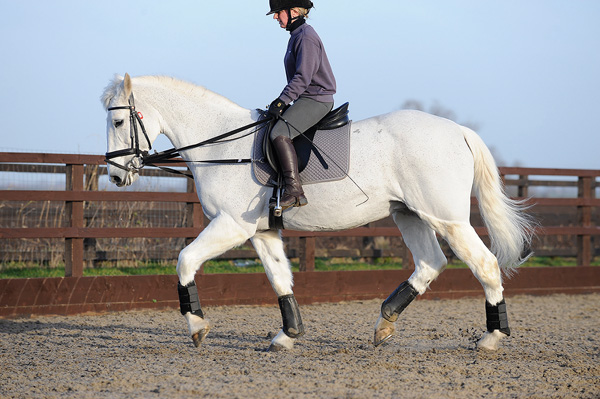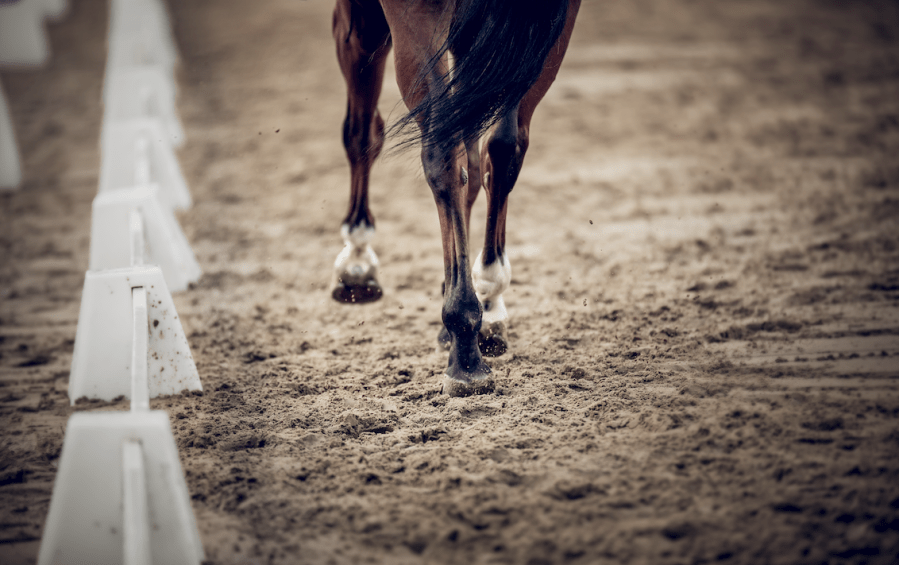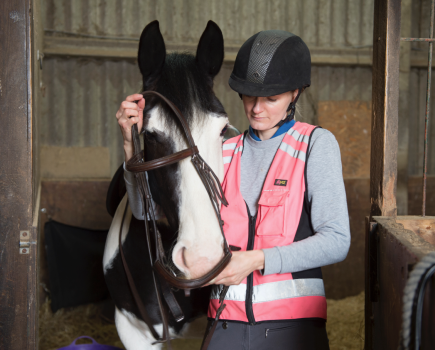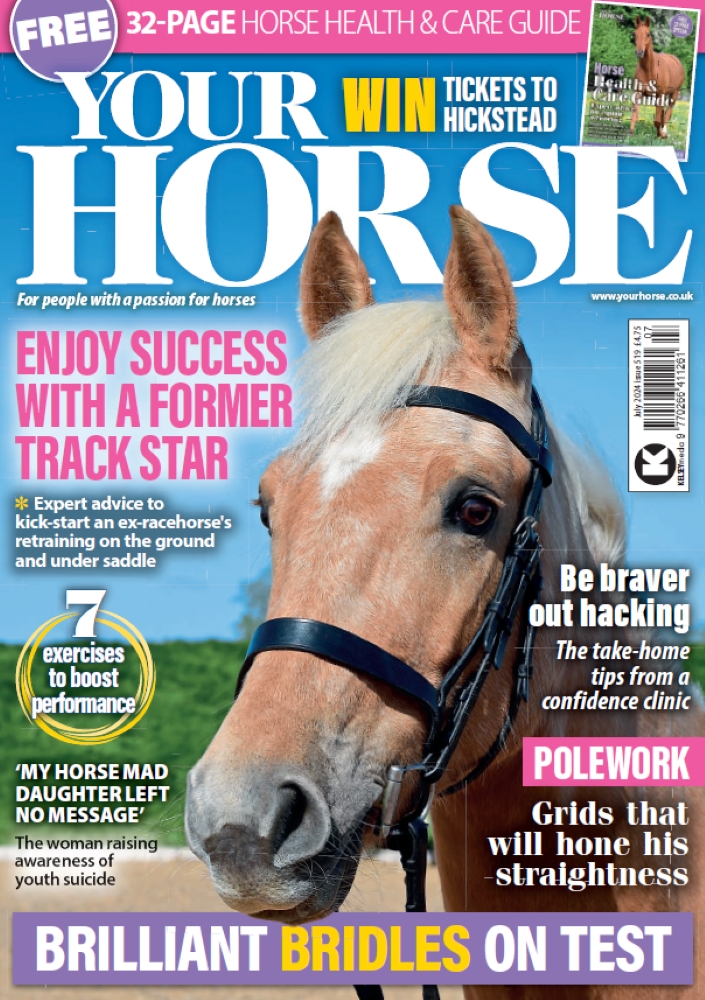Draw reins for horses might be found in some tack rooms and detested in others. Draw reins often trigger heated debates amongst the equestrian community. Made of leather or a webbing material, they are designed to go through the bit and to attach either to the girth between the horse’s front legs or to the girth straps on both sides of the saddle. When draw reins attach to the girth straps they are sometimes known as running reins.
The basic principle of draw reins for horses is that they feel pressure on the bit ring and this changes the contact and/or the position of the horse’s head and neck. It takes a lot of skill and correct timing of the rider’s aids to show the horse that they can lower their head and draw their neck forward to meet the contact of the rider’s reins, which are attached to the bit rings as normal. It’s important that the use of draw reins does not become routine. In this article I will explain when you might use them, the problems with their incorrect use and the responsibility we as riders have to consider carefully whether to use them.
How should draw reins be used?

When attached to the girth straps, draw reins may be referred to as running reins
I always caution riders to use draw reins with extreme care. I would tell an inexperienced rider not to use them and I will explain why later on. Draw reins must always be used with a second pair of reins, so you need to be skilled at riding with a pair of reins and able to soften the contact on the draw reins immediately, as needed. You also need to be able to ride with an independent seat and to be able to ride effectively, using your leg aids and receiving the contact as a two-way communication with your horse.
Draw reins are a training aid. They are a guiding rein that must only be used with a snaffle bit. When the rein comes into use, it acts on the bars and the corners of the mouth, applying pressure to the horse’s poll. The rider must keep the reins equal and not allow the reins to become twisted.
Remember that a horse must never be asked to carry their head behind the vertical. This false and dangerous practice is known as hyperflexion/Rolkur and causes pain, tension and incorrect movement.
Draw reins for horses: no pressure
Draw reins should mostly be inactive, with the horse feeling no pressure from the reins when working correctly forwards and into a contact. A horse who understands the action of the draw reins will notice the feel and extra weight of the second rein through the bit ring and not do anything that causes the draw rein to come into effect.
There are two important things to remember:
- Working in any unfamiliar posture is incredibly tiring and your horse will need to be allowed to regularly stretch and relax, having the freedom to ease their muscles.
- A horse might respond to the draw reins by tucking their chin in and dropping behind the contact, withdrawing from any kind of communication with the rider and working in a false outline. We want to avoid this damaging posture and I will go into more detail about it shortly.
How to fit draw reins
Double reins: correct position
To correctly fit draw reins for your horse, first place the reins over their neck with the central buckle placed over the wither. Remember that your snaffle rein takes the place of the Bradoon rein of a double bridle. This means it is the top rein and the one that you predominantly use when riding. The draw reins will pass through the bit below the snaffle rein.
Check the length
When you have each of the draw reins through the bit, check that they are equal length before you clip them to the attachments. You will need to select a girth with a ring at the front or use an attachment with a ring that loops over the girth and gives you a central attachment.
If you are using the draw reins on the girth straps, you can place a ring attachment loop over each strap. Sometimes you will see riders clip the rein to the buckle part of the girth, but this is a risk because of the tension. It might be better to choose running reins that have a buckle attachment rather than a clip so that they can be fitted as you would side reins.
Correct attachment
Thread each rein under all of the girth straps. Next you return the strap over the top of the end girth strap and under the first strap before adjusting the buckles. Remember that these must remain equal in length.
Don’t forget that draw reins are long — perhaps 15-17ft long — and so when fitting them, make sure they do not drag on the floor. If they do, you risk the horse getting a leg caught or the reins twisting.
Practice caution
Draw reins attach to the bit in the horse’s sensitive mouth, so don’t leave your horse tied up or in a stable wearing draw reins for fear that they might get caught. This would scare the horse and can cause pain. It’s a good idea to put a gentle knot in the rein so that they can lie against the horse’s neck while you make your checks and final adjustments.
Using draw reins for horses for the first time
The first time you use draw reins, your horse might be confused by the unfamiliar feel. Potentially they might panic or at the very least feel uncertain about what you are asking of them. Before letting the draw rein act on the bit, warm up your horse in their natural frame using only the snaffle rein.
Your focus should be on establishing a regular rhythm and making sure that your horse understands and reacts to your leg aids. When your horse is relaxed, you can carefully take up a gentle feel of the draw reins to guide the horse to lower their head and neck. The horse will be looking to you for guidance. Use your leg aid to ask them to go forwards and seek the contact in the snaffle rein.
Subtle use of draw reins
As your horse lowers their neck, you subtly ask them to stay in the snaffle rein contact by applying your legs quietly and relaxing the draw rein at the same time. Think forwards! It’s not about pulling your horse backwards into a better outline. Of course you can talk to your horse, praising them for relaxing and accepting the suggestion of the reins.
If your horse does panic, release the draw reins and encourage them to go forwards into a familiar rhythm again. As I have already said, be mindful in every moment that you are not pulling on or leaning on your reins. You need to be confident that what you are asking your horse to do is okay. If you are tense and unhappy your horse will pick up on this uncertainty and they are likely to become uncertain too. If things are not working and you feel worried, stop and discuss the challenge.
Riding with draw reins
Riding in draw reins is a task for a skilful rider. In fact, it’s often been suggested that the few riders who are skilled enough to use them probably don’t need them. Draw reins for horses are not to be used as a short cut in training. There are times when they are helpful and it’s worth exploring with your coach if you are ready to use them or if there might be a more appropriate choice.
I think it is helpful for me to share some of the occasions when I have used them. I will also share with you some of the instances where a horse schooled in draw reins has arrived with me and was not in a good physical or psychological place, and what I did next.
Fragility through the reins
The first time I rode a horse in running reins, I was trying a horse to buy, I felt a sense of fragility through the reins and I didn’t like the lack of conversation I had with the horse. I was still in Pony Club and terrified of the running reins. I barely touched them but fell in love with the horse. We bought him and he stayed with us his whole life. At 15 I thought I’d go straight back to basics and put a snaffle bit on with a plain noseband. There followed a terrifying few months of being unable to stop or steer.
This horse formed a strong bond with my mum and, as we didn’t have an arena, I had to hack. The only way to hack him safely was for him to follow my mum! In open spaces he would brace and then spin. My younger self had no idea what to do about this apart from ride circles and transitions. I had a few lessons with a local trainer, who introduced me to the basic principles of leg yielding and I started spiralling in and leg yielding out on a circle.
Back to basics
Eventually, we achieved a connection where I was able to influence the position of the horse’s head and neck. Lowering his neck, moving in a regular rhythm and listening to my leg aids as well as my voice took us to a new level of understanding. I know we could not have achieved this if I had not stripped his tack back to basics and removed the draw reins.
If I could go back in time to talk to younger me and spend some time with my horse, I would explain that he was not rejecting me with his scary behaviour and I would reassure the horse that we were heading in the right direction. Fear on both sides in this partnership was based on lack of understanding. I remember being determined that I could find a way to rehabilitate this horse and eventually we got there. I’m sharing this with you to say that I empathise with feeling out of my depth and trying to communicate with a horse.
Positive effects of draw reins
This experience led to me blaming the previous use of draw reins for every problem and challenge my horse had. So it took a lot to convince me later on that I could use draw reins in a positive way for horses. I did not ever want to be the rider that did my horse any harm.
I was honoured to be asked one day to cool down a dressage horse who was rather bigger than I was used to riding. He was powerful, happy and that day he was wearing draw reins. I did not know what to do! My instructor helped me through the feel of trotting around in the snaffle rein with a correct contact and gently holding but not using the draw reins. It was an honour and a joy to ride that horse and I was elated to know we had good communication. Fears of breaking him disappeared and I was thankful for the lesson in feel he gave me.
Fast forward several years, I was given a standardbred trotter to school and promptly presented with draw reins. Conformationally, this horse had a rather short neck and it was not possible for him to work in the frame the owner was seeking. My solution? I took the draw reins off and showed them how to focus on helping the horse to relax in the jaw and at the poll. I used a simple walking on a circle exercise as well as leg yielding, with regular breaks, and the horse learned to relax into the posture that worked best for him. He soon chose to stretch over his back and, as his balance improved, so did his confidence and relaxation. I know this way of going was not going to be achieved with draw reins.
Draw reins for horses: more control
A decade later, having ridden many more horses, I got the ride on a lovely former event horse who knew way more than I did. He was the ideal schoolmaster, but after a spell of box rest it was time to bring him back into work with no turnout or lunging allowed. Well, suddenly I was an apprehensive rider tasked with getting on a fire-breathing dragon who was on full alert. I didn’t dare breathe — let alone put my leg on. He was locking onto anything that moved and I was at a loss as to what to do.
My coach suggested that it would be safer to ride in running reins and I reluctantly agreed. Now I think the horse knew exactly what those draw reins were asking; he snorted in disgust before seeking the contact and lowering his head. He felt more like my horse in that moment and I prayed as I applied my leg. Nothing untoward happened! He simply stretched his neck forwards, the wrinkles of tension at the base of his neck disappeared, and I released the touch of the draw rein.
His ears returned to work mode, flickering back at me asking for praise. I heaped words of gratitude on him and promised endless mints if only he would keep his feet on the ground and order was restored to our world. A fortnight later he was allowed turnout and the draw reins stayed on the fence.
Tell-tale signs of misusing draw reins
The horse I want to tell you about now arrived with the tell-tale signs that he had been ridden in draw reins. There was a ‘dip’ in the musculature at the base of his neck; he tucked his chin into his chest and he had the appearance of a short and scrawny neck. When riding him, he was rock solid against the hand and had little muscle development behind the saddle or on his quarters.
This horse moved in a flashy yet tight way. His trot was all about his front legs and his canter was not really going anywhere. I experimented with different snaffle mouthpieces to find the one he liked. He enjoyed going sideways and he understood counter canter, so I used these exercises to help him develop suppleness. Lateral suppleness encouraged him to breathe and to let go of tension. Equally, longitudinal suppleness helped him understand the link between balance and communicating with his rider. (Half halts became more nuanced, with a gentle massage of my fingers on the reins and subtle changes in my seat.)
Low and behold, this horse began to enjoy moving his body. He was proud of himself and liked to show off, especially in the dressage arena. However, he was a nightmare to hack and far more dangerous than my other horse, as he had zero self preservation. Alas, my mum returned to walking duty. Once again I felt angry and sad that draw reins had robbed this horse of his early understanding of the world.
Draw reins for horses: yes or no?
You won’t be surprised to hear that I’m still mostly on the side of leaving draw reins in the tack room when it comes to choosing whether to use them or not. However, I am thankful for having the knowledge and understanding of how to use them correctly — and when they might have a role to play in helping a horse and rider develop.
I would like every rider to have the opportunity to learn how to work a horse correctly. There is a place for draw reins for horses, but they are easily misused and it’s our responsibility as riders to question why we use them. We must make sure that when they are used it’s in a tactful way to guide a horse towards having a more relaxed posture and focus. That is the end goal.
Main image: copyright Shutterstock. Inset: copyright Your Horse Library/Kelsey Media Ltd








